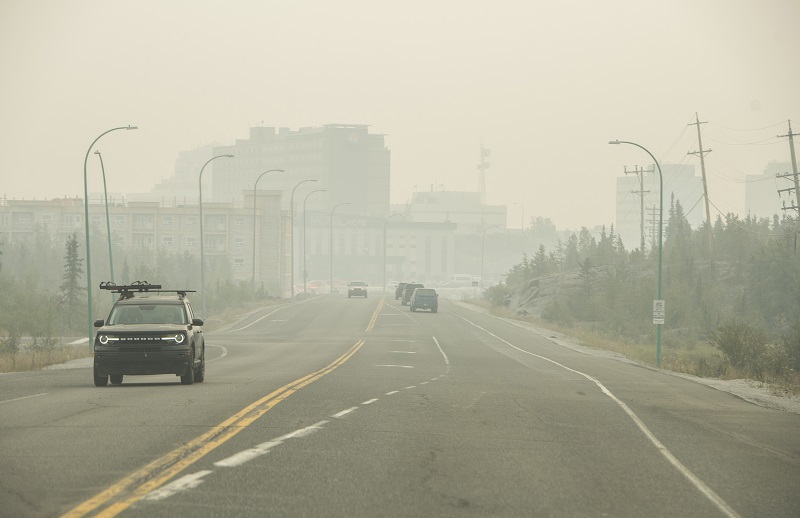Adjusters handling early claims from N.W.T. wildfires

Insurance adjusters are preparing for an influx of claims as wildfires continue to burn in Northwest Territories, with the capital city of Yellowknife coming under an evacuation order as the flames are predicted to arrive at the city’s doorstep on Saturday.
“We anticipate total losses, as well as many smoke damage and [additional living expense] claims from surrounding towns and communities not directly in the path of the fires,” Trent Buchanan, district manager for Alberta & Territories with ClaimsPro, told Canadian Underwriter Thursday. “We have local adjusters in Yellowknife handling early reported losses, as well as adjusters from outside provinces on standby to assist immediately.”
It’s estimated between 80% and 90% of the hamlet of Enterprise — home to a little more than 100 people — has been destroyed, including homes and businesses, according to media reports.
“The town was gone pretty much,” Hay River, N.W.T., resident Tanisha Edison told Canadian Press after she travelled through Enterprise en route to a fire evacuation centre in Alberta. “No buildings left. It was just metal frames melting.
“You couldn’t even read the signs because when the fire blew through there, they were all melted,” said Edison, who is expecting a baby in days. “Trees were like ashes. Everything was like ashes and on fire.”
The community has about 40 to 50 houses remaining, Buchanan estimated.
“The area is heavy on the industrial side with many commercial buildings such as trucking companies, gas stations, and government properties,” he said. “Our Alberta-based specialty risk division is assisting as we anticipate losses coming in from the large commercial operations and fuel distribution centres in Enterprise.”
People without vehicles lineup to register for a flight to Calgary, Alberta in Yellowknife on Thursday, August 17, 2023. Prime Minister Justin Trudeau is expected to convene an urgent meeting with ministers and senior officials today as residents of the capital of Northwest Territories are ordered to evacuate the area because of an encroaching wildfire. THE CANADIAN PRESS/Bill Braden
Three major fires are burning, with the territorial government saying Fort Smith and Hay River remain at risk due to wildfires. Yellowknife is also at an increased risk from a wildfire approaching from the west.
“There will also be large numbers of Indigenous communities within the paths of all three major fires,” Buchanan added.
While evacuation orders remain in place and some fires considered out of control, it’s still early to have a full-picture understanding of the damage or make any assessments based on claims coming in so far, Buchanan said. “Once people make their way back to the community, we will have a clearer idea of things,” he said, adding that the last time there was an “extreme fire season” in N.W.T. was 2014.
Glenn McGillivray, managing director of the Institute for Catastrophic Loss Reduction, said it’s too soon to say whether the fires will be considered a Cat (insured losses of $30 million or more). “We do not yet know what the structures are, whether they are insured, etc.,” he said in an email Thursday.
Enterprise has a population about half of Lytton, B.C.’s. “About 90% of Lytton was razed by fire in 2021, with the insured loss coming in at just over $100 million,” McGillivray said. “We will have to see what happens in Fort Smith and Yellowknife.”
Residents of Yellowknife were ordered to evacuate Wednesday night as wildfires neared the city of about 20,000 people. People were given until noon Friday to evacuate as one wildfire advanced within 16 kilometres of the city, CP reported.
The current size and rate of travel of each fire fluctuates on an hourly basis, with a strong possibility of new fire igniting throughout N.W.T. and northern Alberta, Buchanan said. “Our national Cat response team is on high alert and monitoring the situation around the clock.”
As of late Thursday morning, there were 236 active wildfires in N.W.T. Municipal and Community Affairs Minister Shane Thompson declared a territorial state of emergency “to allow the Government of the Northwest Territories to acquire and deploy the necessary resources to support the management of this unprecedented wildfire season, and protect the health and safety of Northwest Territories residents.”
McGillivray reported that wildfires — including in and around Yellowknife — in the terrority are “very common. Canada’s boreal forest is where the lion’s share of big fires in the country occur and much of the Northwest Territories is covered by boreal.”
One major challenge when isolated communities in Canada must evacuate is that there’s often only one way out of town, or two if a highway runs through a community, McGillivray said. This can lead to choke points and slow, perilous evacuations if the order to leave comes late.
“All too often, we seem to want to play a game of ‘chicken’ with fire,” McGillivray said. “Thankfully, officials in Yellowknife seem to want to take no chances and the order has come down to evacuate the city by Friday noon local time.
“The other challenge is getting suppression resources where they are needed. The big issue this year is that many provinces are running all out and are having difficulties deploying assistance to other provinces.”
Feature image: Heavy smoke from nearby wildfires fills the sky in Yellowknife on Tuesday, August 15, 2023. THE CANADIAN PRESS/Angela Gzowski





